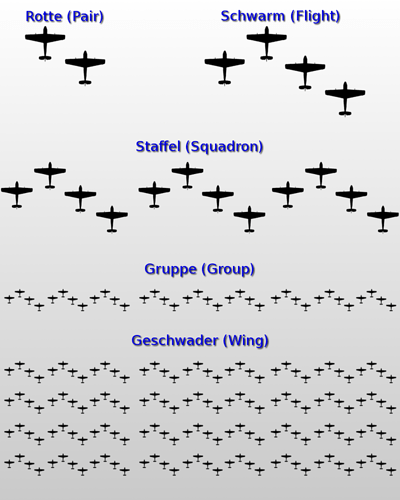Just a short clip of a bf110 actually surviving a dogfight! Thanks to a wingman.
Rottenflieger.
A ”Staffel” is made up by several ”schwarm” that generally consist of two ”rotte” each.
A ”Rotte” is two aircraft.
We use the term in Sweden as well, although pronounced and spelled slightly different; ”Rote”.
Correct.
The “Rotte” could be further separated in “Rottenführer” (lead) and “Rottenflieger” (wingman).
There was also the inofficial term “Katschmarek” for wingman in WW2 Luftwaffe.
Horido!
Then when I fly a 190, I usually fly with Rottenluck.
Never heard that one. What would a litteral translation to english be?
It is a Polish last name, and means “innkeeper” or something like that.
I have no clue why they used it to mean wingman.
Ok I did a quick research and found something:
Kaczmarek is (or was) a pretty common Polish name, derived from the profession of innkeeper.
It is related to the Czech “Kremar” and the German “Kretschmar”.
For Germans from the area of Ostpreußen (eastern parts of Prussia, parts of it are Lithuania now, others are Poland) the Polish stereotype is a bit like the one an Englishman or American would use to describe someone from Ireland: friendly but a bit dumb (also often drunk).
So, the friendly and loyal, but dumb “Kaczmarek” or “Katschmarek” is a name for someone who follows you around doing what you say. Patrick from “Sponge Bob”, Randy from “My name is Earl” and so on.
It seems the stereotype and even the name for it has been around for quite a while (from Prussian times), often in a military context (the stereotypical recruit is a bit dumb and slow, he still has to learn how to be a real soldier) but also outside of it. Prussia was the dominating force in Germany for a long time, especially in military.
The term is slightly pejorative, but when applied to your comrades it is mostly tongue in cheek and refers to the task of being the subordinate.
The usual tactic of a Rotte was that the lead attacked, and the wingman followed him, most of the time not doing the shooting, watching his back. Basically what we call the “fighting wing” tactical formation.
So I guess that’s why they used the term, because of the following around not thinking a lot, but still being a loyal friend to rely on.
At least that’s what I could find.
Nice job!
Sounds like a plausible explanation.

